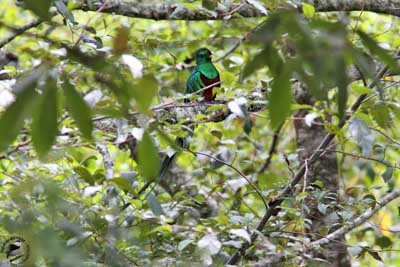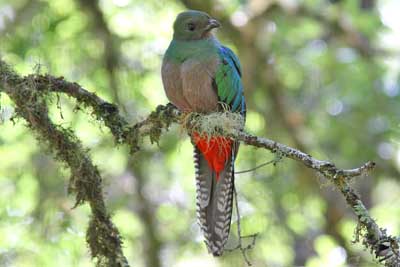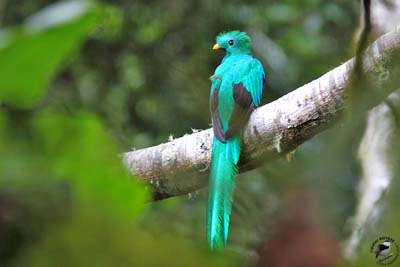
Fr: Quetzal resplendissant
All : Quetzal
Esp : Quetzal Guatemalteco
Ital: Quetzal splendente
Nd: Quetzal
Photographs by Didier Buysse
Vision d’Oiseaux
Text by Nicole Bouglouan
Sources :
HANDBOOK OF THE BIRDS OF THE WORLD Vol 6 by Josep del Hoyo-Andrew Elliott-Jordi Sargatal - Lynx Edicions, 2001 - ISBN: 848733430X
A GUIDE TO THE BIRDS OF MEXICO AND NORTHERN CENTRAL AMERICA by Steve N. G. Howell, Sophie Webb - Oxford University Press - ISBN: 0198540124
L’ENCYCLOPEDIE MONDIALE DES OISEAUX - Dr Christopher M. Perrins - BORDAS - ISBN: 2040185607
Animal Diversity Web (University of Michigan Museum of Zoology)
BirdLife International (BirdLife International)
Wikipedia (Wikipedia, The Free Encyclopedia)
Resplendent Quetzal
Pharomachrus mocinno
Trogoniforme Order – Trogonidae Family
BIOMETRICS:
Length: 36-40 cm + 65 cm beyond the tail tip
Weight: 180-210 g
DESCRIPTION:
The Resplendent Quetzal was considered divine by Pre-Columbian civilizations. “God of the Air” for the ancient Aztecs and Maya, and symbol of goodness and light, it was a crime to kill a Quetzal.
This species is the Guatemala’s national bird.
The Resplendent Quetzal is mentioned in several legends, and its name also means “precious”, “sacred” or “erected” in Mesoamerican languages.

The Resplendent Quetzal male has bright iridescent blue-green upperparts, throat and upper breast, but the colour differs according to the light, and we can see golden-copper iridescence.
On the upperwing, the elongated greater coverts which extend beyond the line of the closed wings are similar in colour to the upperparts. The flight feathers are blackish.
On the tail, four elongated, narrow, filamentous uppertail coverts named “streamers” also have iridescent blue-green.
On the underparts, lower breast, belly and undertail-coverts are red. Undertail is white.
On the head, two laterally compressed disks made with green filamentous feathers extend around the eyes, forming a kind of short crest in the middle of the crown.
The yellow bill is partially hidden at base by these feathers. Eyes are dark brown. Legs and feet are pale pinkish.
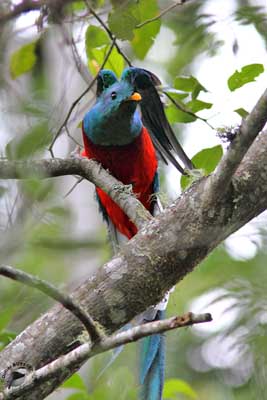
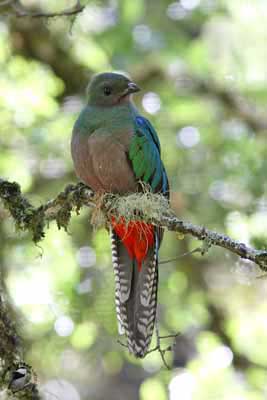
The Resplendent Quetzal female is different with duller plumage and shorter tail.
She has green upperparts, throat and upper breast. The green greater wing coverts and uppertail coverts are fairly elongated.
Primary flight feathers are blackish, with buff outer webs. Uppertail is blackish.
On the underparts, lower breast and upper belly are buffy-grey. Lower belly and undertail coverts are red.
Undertail feathers are conspicuously barred grey-black and white.
Head is bronze-green. Bill is blackish to yellow.
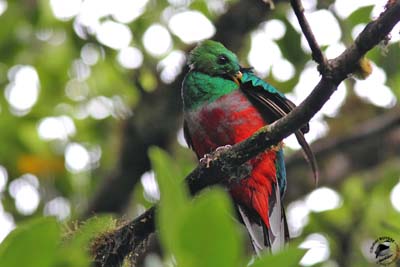
Immature is similar to female with yellow bill, bronzer upperparts and more white in undertail.
We find two subspecies:
P.m. mocinno is found in S Mexico, Guatemala, Honduras, E El Salvador and NC Nicaragua.
P.m. costaricensis is found in Costa Rica and Western highlands of Panama.
This one is slightly smaller than nominate, with shorter and narrower uppertail-coverts.
VOICE: SOUNDS BY XENO-CANTO
The Resplendent Quetzal’s calls include a fairly hard “k’wak”, and a steady “ka-ka-ka…”
During the flight displays, or when the bird is excited, we can hear a rolling chatter “kwar-ahrr-rrak…”
The song is a plaintive, steadily repeated “k’yoi-k’yow k’yoi-k’yow…” or “whee’o-whee’u whee’o-whee’u…”
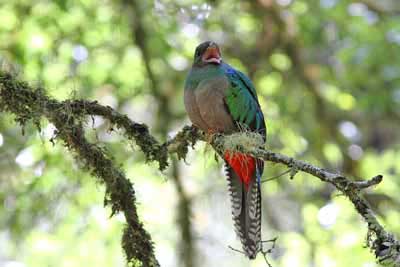
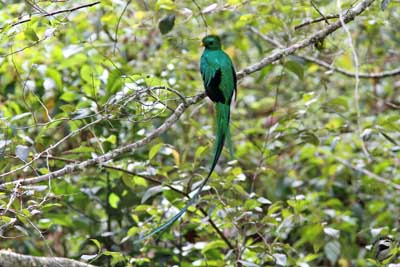
HABITAT:
The Resplendent Quetzal frequents humid evergreen forest, and is often perched high in trees. It is also found in well vegetated ravines and cliffs, but also in clearings and pastures, and open areas with scattered trees close to the forests. This species is visible from 900 up to 2300 metres of elevation in S Mexico, and from 1200-1500 metres up to 3200 metres farther south.
RANGE:
See above in “subspecies”.
BEHAVIOUR:
The Resplendent Quetzal is primarily frugivorous, feeding mainly on fruits of Lauraceae. But it also takes some invertebrates such as beetles and their larvae, flies, orthopterans and moths, and small vertebrates such as lizards and frogs, and snails.
It performs sallies to pluck fruit, and numerous birds may gather in one tree at the same time.
The Resplendent Quetzal is a good hunter, swooping down onto the prey for snatching it. It swallows the food while flying.
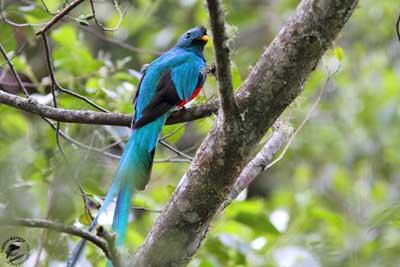
The green plumage provides an excellent camouflage when the bird perches in trees.
The male is territorial and chases away from the nest-site all predators and intruders, using direct flight at them while giving a swearing call.
During the territory defence, it gives melodious whistles of two high-pitched notes, repeated at ten minutes intervals.
During the breeding season, the monogamous males often displays in groups of ten to twenty birds. These groups are not leks because the behaviour is different, and after the displays, each male returns to its territory and joins the female which has remained there.
But some males are alone, and the Resplendent Quetzal appears to use these displays and dances to attract a mate. Several males can pursue noisily one single female flying from branch to branch.
Once the pair is formed, they build the nest together and mate inside the cavity.
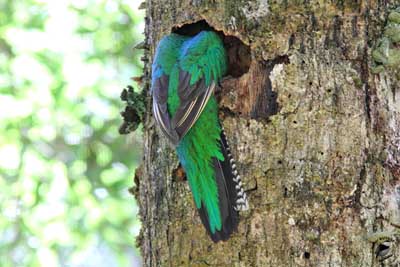
The Resplendent Quetzal is resident in Mexico, only performing altitudinal movements according to the food resources. Some local migrations are observed in Costa Rica.
FLIGHT:
The Resplendent Quetzal, as other Trogons, has rounded wings allowing strong flight action. This bird flies very well in the limited forest space.
It performs undulating flight over longer distances, interspersed with series of rapid wing-beats.
During the flight, including the flight displays, the long uppertail-coverts follow the movements of the bird.
REPRODUCTION:
Breeding season varies according to the range.
The Resplendent Quetzal nests in tree holes, sometimes in abandoned woodpecker’s nest.
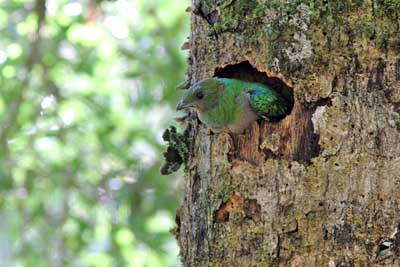
The cavity is excavated by both sexes in decaying bark and wood. They do not add any nest materials as lining.
The hole is about 10-12 cm of diameter, and placed between 4, 5 and 27 metres up in trunk or stump in the forest or close clearing.
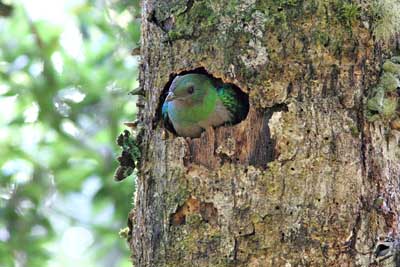
Female usually lays two pale blue eggs on the bare floor of the cavity. Incubation lasts 17-19 days, and both parents share all the nesting duties.
Chicks are brooded by male and female during the first week. They are well feathered two weeks later, except on the head.
They are fed with insects during the first days, and parents clean the nest regularly. At two weeks of age, they are fed with fruits and small vertebrates added to the insects.
They remain at nest during three weeks and then, the male helps them to fly, feeding and tending them when they are going out from the hole.
They remain some times with their parents. The males need three years to develop the beautiful adult's feathers.
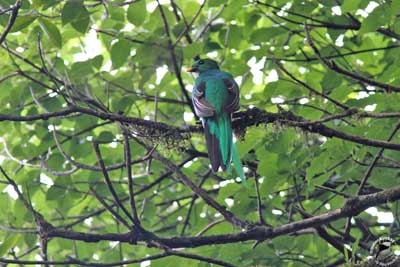
DIET:
The Resplendent Quetzal feeds primarily on fruits from Lauraceae, but it also takes insects, small frogs, lizards and snails.
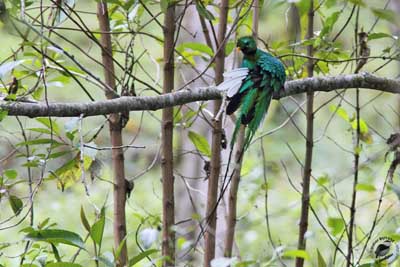
PROTECTION / THREATS / STATUS:
The Resplendent Quetzal is strongly protected in its range, and several national parks have been created to protect this species.
Populations have decreased, due to forest clearance, cloud forest destruction, trapping for illegal pet trade and hunting for feathers.
However, the Resplendent Quetzal is relatively common in remote areas of the range, but the species is considered as NEAR THREATENED.
